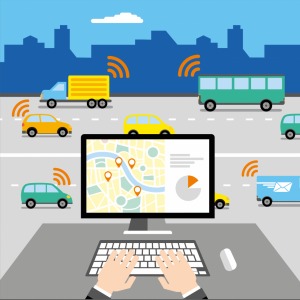 The general perception is that logistics and transportation business correspond to trucks and modular infrastructure. However, in recent years, the logistics industry has completely acquired a new face and perspective; thanks to the ever-evolving technological innovations that are taking the world by storm. As the growing demands, new consumption patterns and global treaties continue to impact warehousing and transportation formats, advancements such as mobile computers, GPS solutions, Internet of Things (IoT) and many more have provided a new dimension to logistics.
The general perception is that logistics and transportation business correspond to trucks and modular infrastructure. However, in recent years, the logistics industry has completely acquired a new face and perspective; thanks to the ever-evolving technological innovations that are taking the world by storm. As the growing demands, new consumption patterns and global treaties continue to impact warehousing and transportation formats, advancements such as mobile computers, GPS solutions, Internet of Things (IoT) and many more have provided a new dimension to logistics.
Technology is the driving force
Moreover, for enterprises where transportation and logistics have a major role in their productivity and access to real-time data is crucial, technology has really emerged as a driving force in improving their operational efficiency and performance. The tech support is also creating a positive influence on the highly interconnected supply chains, providing scope for intensive businesses to interact and collaborate on the transport, storage, and management of goods and service across borders.
The need for transportation companies is to keep abreast of this growing technological change and maximize its potential. While there is an increasing stock of new technologies that can impact the transportation and logistics industry, here are the critical ones to keep on your radar.
Robot is the key!
From advancing package labeling to streamlining warehouse sorting systems, automation utilises data-driven software to boost operational efficiency in machines. On the other hand, robots are equipped to handle and execute multiple tasks simultaneously and have numerous applications in the logistics industry.
Robots have the ability to fulfill orders in less than 15 minutes as compared to manual execution that typically takes around 60-70 minutes to complete. This reduces the company’s operating expenses resulting in higher efficiency in warehousing and delivery.
Shifting Trends: The best of IOT
Using the Internet of Things (IoT), enterprises can connect all devices across a centralised cloud network, capture and exchange critical data, and get real-time visibility of transport operations. IOT facilitates in monitoring equipment, remotely controlling devices and receiving alerts when machines are in need of servicing or repair. Basically, IOT represents a larger solution system and telematics is a part of this extended network. The whole infrastructure is meant to boost activities in the ordering, manufacturing and warehousing chain.
No shortage of stock now!
On the other hand, inventory management is experiencing a major change. Now machines with help from forecasting data can anticipate when resupplies like new parts or consumables are necessary before the stock is exhausted. So alerts will be activated for replenishing the stock material. With such stronger demand signals, the supply chain will have to be more geared up and responsive. The presence of an IOT domain also helps when transport operations are in progress. Trucks are able to monitor essentials like temperature, vibration and other factors that affect the condition of the load.
Better technology, greater visibility
The IoT monitors not only extract complete information about the truck and environment but can remain with a shipment across multiple international transportation methods from shipping to truck to rail to steamship to yard storage to rail to truck to delivery. So, logistics companies can provide great insight and understanding to shippers and receivers. Besides, the data is crucial for cold chain or production applications.
With low-cost sensors and Bluetooth wireless technology readily available, it is now easy to add trucks to the increasing online network of supply chain data, providing last – mile visibility that wasn’t possible earlier
The impact of cloud computing
Cloud Computing is transforming the transportation Industry in many ways. For years traditional transportation was using a local network to know more about a vehicle’s diagnostics and passenger counts. With cloud computing, stakeholders in the transport industry are able to store more fleet data and thereby enhance the information flow in the industry. For years, even though telematics and RFID (Radio Frequency Identification) and other technologies were providing ample data, companies could not really harness the potential of analytics and neatly organise the data. But now with sophisticated and smart software and data architectures, all data can be effectively controlled and manipulated to generate elaborate activity reports and process activity and process flow, as well as provide predictive advice to improve operations and problems before they occur.
Fleet Management and Telematics: The call for safety
Since long, logistic companies have been using GPS systems to track the location of their trucks. Now GPS-based innovative fleet management systems have evolved with many attractive features and functions. The comprehensive software provides the users with a real-time access to valuable and critical information about vehicles. Logistics managers can actually view the truck locations, and set up geofences to generate automated alerts when a truck is close to its destination or has moved out of its service area. Fleet management software also helps improvise vehicle utilisation and automatically monitor the driver hours as well. The functions of telematics enable to monitor the maintenance needs of vehicles so that breakdowns can be prevented. Organizations use solutions that can track the speed and conditions harsh braking or acceleration excessive idling and many other factors that cut down on fuel consumption and cost, thereby ensuring and improving overall safety.
Big Data is indeed a Big Deal
Data-driven decision making is vital for supply-chain activities and hence the transportation industry is focusing on maximising the potential of Big Data and Analytics. Considering the factors that can influence this industry, from weather conditions to vehicle usage to automation, access to real-time information is most significant for enhancing efficiency. Here’s how Big Data is shaping the following areas
- Traffic management: Combating traffic is a big challenge for all and sundry. But Big Data can help to predict and manage congestion to curb traffic and enhance traffic management. With real-time information, historical trends and clever algorithms put together, big data is translating weather reports, car speeds, community events and sources of acceleration and deceleration for road operators. Moreover, firms are able to extract huge data from local transport authorities because of available sensors that are built on transport networks and fleet vehicles. Big Data also aids traffic authorities with intelligent information about effective traffic management.
- Logistics and Supply Chain: The logistics and supply chain management can draw great benefits from the use of Big Data and Analytics. Based on delivery sequences, traffic conditions, and recipient status, Big Data facilitates faster deliveries using real-time route optimisation. Earlier shippers and supply chain entities had to depend on historical data for understanding customer requirements. Now customer needs and requirements are better looked after with technological advancements. Forecasts can be modified as and when the need arises, making way for better allocation of resources and optimization across supply chains.
It is only by embracing technological innovation and adapting to the change that the transportation and logistics industry can gain a competitive edge in the market, do great business and envision a better tomorrow for itself and its customers as well.














